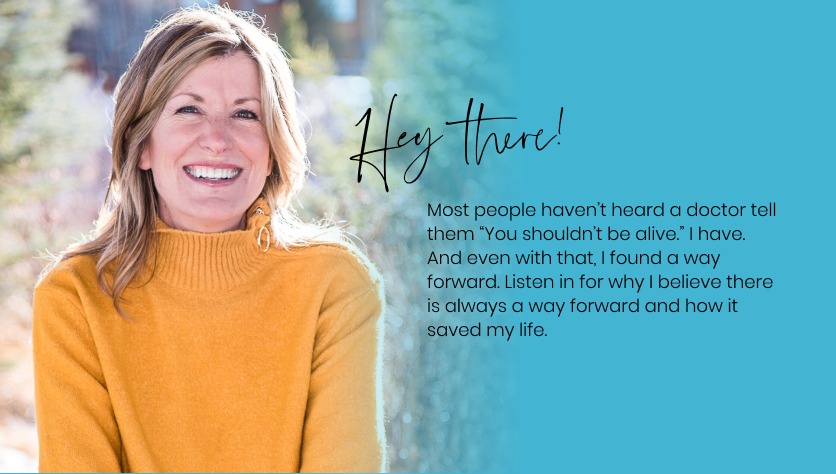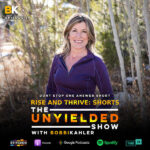As I was sharing this with Cindy, another woman, who was standing nearby said, “Well, my husband has a bad back and it must be way worse than what yours was and it’s because he used to play a lot of sports so there’s nothing he can do about it.”
And, maybe all of that is true: but do you hear how the answer that they have arrived at leads to the conclusion that nothing can change.
We don’t need to look any further, because we have the answer so the search for something new or better is over.
The inherent problem is that once we think that we can’t change something, we don’t work to change it. And, then, nothing will change.
I’ll never forget when my mom was in the final few months of her life. Her body was completely ravaged by disease. On top of that, she had a few vertebrae that had very slight fractures in them. I can’t imagine how painful it was. Her one doctor told her that it would be best if she would still get up and move around. Nothing wild mind you, but simply getting up and walking around would help.
This woman, who had to be in screaming pain and who was so terribly ill, made it a point every day to get outside and walk in their driveway. This was before Fitbits and the like, so she counted her steps every day. She went out three times a day and did this.
At first, the most that she could do was 20 steps at a time. After about a month, she would proudly email me that she was up to 500, each time out. She also started telling me that the pain wasn’t as bad and that it was giving her and dad more time to spend together.
So, did it change the outcome for her? Probably not.
But, it changed the time that she had left — for the better, and, according to her doctor, it probably gave her a few more months.
Of all the things that my mom did in her life, this might be the thing that I admire the most: never quitting on herself even in the face of defeat.
I think actually that was one of the great lessons that my mom taught me: there is always another answer or another way or another option – as long as you keep looking for it.
Which brings me to a pivotal question that I ask myself: is the answer that I am locking into opening me up to more possibilities or is it shutting down possibilities?
If it is shutting down possibilities, then I need to look for a different answer. Or, at the very least, I need to challenge that answer.
How can we challenge an answer?
The first and most important thing is to build awareness. We have to recognize when we are landing on an answer and then test it as I described above: is this answer creating new possibilities or shutting down new possibilities. We have to build this in otherwise, we end up on a bit of automatic pilot and we will never recognize how these things are dictating the course of our life.
IF we test it and we notice that we are shutting down possibilities, then it is worth really digging into it and searching for: is there another answer or are there more possibilities than what I am seeing right now? Here are 3 strategies that you can use:
-
Re-examine the situation before you. Is there a different way to frame it? Have you fully explored all of the options? Have you eliminated some options because you don’t like them?On this note, I have to share that when I was having the really bad back problems and Rick did some research and he came back with the idea of cutting out refined sugars and processed carbs, my immediate response was, NO. Because that meant cutting out bread, and trust me, our breadmaker used to get a workout!But, and this is a critical piece: I didn’t tell myself I was going to change and give up bread. I said, I would test it and see what happened. Once I tested it and my back pain went away, it seemed like a no-brainer to change. By the way, the notion of testing versus changing is something that I will explore more in a future episode.
- Take yourself out of it. When it’s personal, the stakes are sometimes high and that can get in the way of us thinking as expansively and as creatively as we might otherwise be able to do. So, instead of thinking of it in terms of “what other options do I have?” think about it terms of a friend or a colleague is coming to you with this situation and they want help brainstorming options and ways of seeing it. List out every option that your friend might have. Do not judge or censor during this time. This has worked for me and I’ve used it in coaching sessions with others. It’s a remarkable tool. To be completely transparent, I learned this one from my own coach some 25 years ago. I was amazed how well it worked.
- Include others whom you trust. When I was about 18 months into my health recovery (after being told that I had a 3% chance of a full recovery by one doctor), I had gotten to a point where I wasn’t in bed everyday and that seemed like a major victory. On my good days, I could go for very short walks. This state had become my normal – and because it wasn’t as bad as what it once was, it seemed pretty good. (Now looking back, of course, it’s scary!) A friend of mine recommended a new doctor that she had found, DR. Barb. By this point, I had been to many doctors. I lost count of how many doctors that I had seen. And there was a part of me that thought: what is this doctor going to tell me that I haven’t heard already. I was talking it over with Rick and he said, “Whatever you decide, I will support you in. And, I wonder: is where you are really good enough or is it at least worth exploring if there are more answers?” I cannot tell you how incredibly grateful I am to him for gently, compassionately and lovingly, posing that question. Because Dr. Barb, was the first doctor – in 18 months – who said, “I have treated what you have and you can get well again and get your life back.” And, I could have quit ONE answer shy had it not been for Rick.That’s why having someone in your corner that you trust AND someone who can show up without any attachment to their own agenda can be of tremendous benefit in these times. I’m so lucky to have Rick, and it’s also why over the years, I have had a coach that I trust. I really value having that sort of trusted, unbiased thinking partner.
If you want to put this to work for you, start with really looking at the “answers” in your life. Those things that you have decided – and sometimes we decide by default – about how things are, where we are, who we are, why we can’t do something, etc. Really tune into your inner dialogue. When you find yourself rationalizing something or explaining it away, pause and challenge yourself and then use the 3 steps above. I look forward to hearing how this is working for you!








